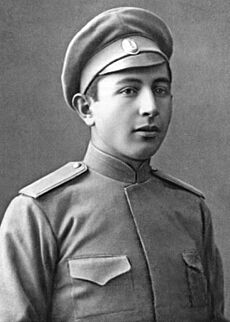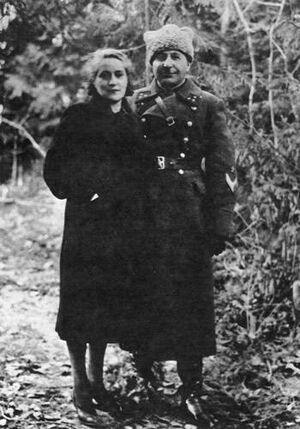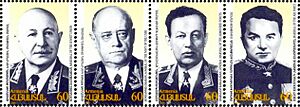Ivan Bagramyan facts for kids
Quick facts for kids
Ivan Bagramyan
|
|
|---|---|
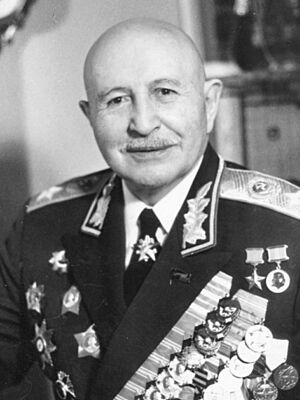 |
|
| Born | 2 December [O.S. 20 November] 1897 Yelizavetpol, Elisabethpol Governorate, Russian Empire |
| Died | 21 September 1982 (aged 84) Moscow, Russian SFSR, Soviet Union |
| Buried | |
| Years of service | 1915–1970 |
| Rank | Marshal of the Soviet Union |
| Commands held |
|
| Battles/wars |
|
| Awards | Hero of the Soviet Union, twice
Order of the Red Banner, Thrice Order of Lenin, seven times Marshal's Star |
| Signature |  |
Ivan Khristoforovich Bagramyan, also known as Hovhannes Khachaturi Baghramyan (born December 2, 1897 – died September 21, 1982), was an important Soviet military leader. He was of Armenian background and became a Marshal of the Soviet Union.
During World War II, Bagramyan was one of the few non-Slavic officers to lead a large army group called a "Front." Many Armenians held high positions in the Soviet military during the war.
Bagramyan was skilled at planning military operations. This helped him become a strong commander early in the war. He got his first army command in 1942. In November 1943, he became the commander of the 1st Baltic Front. In this role, he helped push German forces out of the Baltic republics.
He joined the Communist Party in 1941, which was a bit late for a Soviet officer. After the war, he served in government roles. He was also a regular attendee at Party meetings. For his wartime efforts, he is still seen as a hero in the Soviet Union and among Armenians today.
Contents
Early Life and Dreams
Ivan Bagramyan was born in Yelisavetpol (now Ganja, Azerbaijan). His parents were Armenian and came from the village of Chardakhlu. This village was part of the Russian Empire at the time. Many people in Chardakhlu were from Nagorno Karabakh. Another famous Armenian general, Hamazasp Babadzhanian, was also born there.
Ivan's father, Khachatur, worked at a railway station. His mother, Mariam, took care of their seven children. His parents could not afford to send him to a regular high school, called a gymnasium. So, they sent him to a new two-year school in Yelisavetpol.
After graduating in 1912, Ivan, who was called Vanya by his friends, followed his father into railway work. He went to a three-year railway technical school in Tiflis. He did very well and was set to become a railway engineer. But then, First World War began, and his life changed.
World War I: A Young Soldier
Bagramyan knew about the war on the Caucasus front. In late 1914 and early 1915, the Imperial Russian Army stopped an attack by the Ottoman Empire. Bagramyan also read terrible news about his Armenian people across the border. The Ottoman government had started a campaign to harm the Ottoman Armenians. He really wanted to join the army. But he was only seventeen and a railway mechanic, so he wasn't required to join. He later said, "My place is at the front."
His chance came on September 16, 1915. He joined the Russian army as a volunteer. He trained in Akhaltsikhe and then joined the 2nd Caucasian Border Regiment. This regiment was sent to fight the Ottomans in Persia. Bagramyan fought in battles in Asadabad, Hamedan, and Kermanshah. The Russian victories pushed the Ottoman forces back.
His general, Pavel Melik-Shahnazarian, noticed Bagramyan's skills. He told him to go to the Praporshchik Military Academy in Tiflis. Bagramyan needed a high school diploma to attend. He studied hard in Armavir, passed his exams, and started the academy in February 1917. He graduated in June 1917. He was sent to the 3rd Infantry Regiment near Lake Urmia. But the October Revolution of 1917 happened, and his unit was disbanded.
When the new First Republic of Armenia was formed in 1918, Bagramyan joined its 3rd Regiment. He fought against the advancing Ottoman Third Army. He famously took part in the Battle of Sardarapat in May 1918. The Armenian military won a very important victory there. He stayed in the regiment until May 1920.
Between the Wars
In May 1920, Bagramyan joined an uprising against the Armenian government. Later that year, he joined the Red Army. He was briefly jailed but rejoined the military when the Turkish–Armenian War started. In December 1920, Armenia became part of the Soviet Union. Bagramyan joined the 11th Soviet Army and became a cavalry regiment commander.
Bagramyan found a woman he had met earlier, Tamara Hamayakovna. She had a young son, Movses, whose father had died in the war. Bagramyan and Tamara married in late 1922. They had a daughter, Margarit, who became a doctor. Tamara stayed with Bagramyan until she passed away in 1973.
In 1923, Bagramyan became commander of the Alexandropol Cavalry Regiment. He held this job until 1931. He then went to military schools, graduating from the Leningrad Cavalry School in 1933 and the Frunze Military Academy in 1934. During this time, there were many changes in the Soviet army leadership. Bagramyan's career moved slowly, even as others like Georgy Zhukov rose quickly.
In 1940, General Zhukov became commander of the Kiev Military District. Bagramyan asked to work for him. Zhukov agreed and asked Bagramyan to help write a paper on military operations. Bagramyan's paper impressed Zhukov. He promoted Bagramyan to head of operations for the Soviet 12th Army in Ukraine. Soon after, Bagramyan became deputy chief of staff of the Southwestern Front.
World War II: Leading the Way
Fighting in Ukraine
In June 1941, Nazi Germany launched a surprise attack on the Soviet Union, called Operation Barbarossa. Bagramyan and his commander, General Mikhail Kirponos, expected the invasion. But Kirponos did not believe the Germans would use fast, "Blitzkrieg" tactics. Bagramyan had already planned defenses for western Ukraine.
On June 22, Bagramyan was moving a military convoy. German air strikes hit nearby Soviet airfields. Three days later, Soviet counter-attacks failed. Bagramyan fought in tank battles and the defense of Kiev. He was one of the few senior officers who escaped when the German army surrounded the Soviet forces.
Bagramyan then became chief of staff for Marshal Semyon Timoshenko. He helped plan the fighting around Rostov. Nikita Khrushchev, a political officer, said Bagramyan was "very precise" in his reports.
Bagramyan helped plan two Soviet counter-attacks against the Germans. One was a big push in December during the Battle of Moscow. For this, he was promoted to lieutenant general. In March 1942, he helped present plans for a new attack near Kharkiv to Stalin. Stalin approved the plan. On May 12, 1942, Soviet armies attacked Kharkiv. But the timing was bad. German forces were closing in on the Soviet attack point.
The Soviets initially took back Kharkiv. But then, the German army trapped them. Bagramyan asked to change the plans, but his commanders refused. Soviet losses were huge. Bagramyan was removed from his job on June 28. He was very upset by the loss of so many soldiers. He wrote to Stalin, asking to "serve at the front at any capacity." Some historians believe Stalin unfairly blamed Bagramyan for the failure.
The 16th Army and Kursk
Even though he had not led a fighting unit before the war, Bagramyan was given command of the 16th Army in July 1942. His superiors, especially Marshal Zhukov, were impressed by his planning skills. The 16th Army moved to new defensive positions. In August, German forces attacked, but Bagramyan quickly moved his troops to stop them.
The 16th Army did not see much action until February 1943. By then, the German army at Stalingrad had surrendered. Bagramyan's army was strengthened with more divisions and tanks.
The Battle of Stalingrad was a turning point in the war. In the summer of 1943, Germany planned a new attack at Kursk. The Soviets knew about this plan. They decided to attack German defenses near Kozelsk. This would cut off German forces, similar to how they trapped the German army at Stalingrad.
Bagramyan's 11th Guards Army (the new name for the 16th Army) was part of this plan. It had 15 divisions. Bagramyan thought the plan was too risky. He believed his forces would be spread too thin. He suggested a different plan to Stalin, who agreed. Bagramyan had 20 days to prepare his army. By May 24, his forces were ready. The 11th Guards had 135,000 men, 280 armored vehicles, and 2,700 artillery pieces.
On July 5, the Germans launched their attack, Operation Citadel, at Kursk. They suffered heavy losses. On July 12, Bagramyan's forces began their attack, called Operation Kutuzov. They quickly broke through German lines, advancing 45 miles by July 18. The operation was a success. Bagramyan was promoted to Colonel-General. His forces then helped defeat the German attacks, forcing Germany to stay on defense for the rest of the war.
Victories in Belarus
After Kursk, the Soviets began pushing the Germans out of occupied lands. In October 1943, Bagramyan's 11th Guards Army moved to the Second Baltic Front. Their goal was to take back Belarus and the Baltic republics. In November, Stalin made Bagramyan the head commander of the First Baltic Front. This Front had similar goals but was not making much progress.
Stalin agreed to let Bagramyan keep the 11th Guards Army. Bagramyan was also promoted to Army General. His forces now included four armies. In the winter of 1943, his forces moved towards the Belarusian city of Vitebsk. Many of his soldiers were veterans trained in the Arctic, which helped them break through German defenses.
A key town for reaching Vitebsk was Gorodok. It was a strong German communication center. Bagramyan used heavy artillery and air support to attack the town. His forces launched a three-sided ground attack. The German soldiers were overwhelmed, and by December 24, they surrendered. In Moscow, a 124-cannon salute honored Bagramyan and the First Baltic Front.
On April 2, 1944, Bagramyan's troops were given a break from fighting. However, German forces used this time to attack Soviet partisans in Belarus. Bagramyan's staff helped the partisans escape. As Soviet forces advanced, the German Army Group Center became isolated. The Soviets planned a secret operation called Operation Bagration to destroy it. Bagramyan learned about his role in May 1944.
Bagration involved several Soviet Fronts surrounding Army Group Center. Bagramyan's job was to attack the German forces, cross the Daugava River, and clear the Vitebsk area. He worried about a German attack from the north. He convinced his superiors, Zhukov and Alexander Vasilevsky, to let his Front move west. This would help split the German Army Group North. Stalin approved this change on May 31.
Bagramyan tried to reduce the number of soldiers lost. He planned to surprise the Germans. He had the 43rd Army move through difficult swamps to attack Army Group North's right side. This surprised the Germans, who expected an attack on easier ground. The 43rd Army succeeded in early June 1944.
As Bagramyan moved towards Vitebsk, Belarusian guerrilla fighters helped him. They gave important information about bridges and troop movements. They also attacked German supply lines. On June 22, 1944, Bagration began. Bagramyan's forces moved west. A gap opened on his northern side, but the Second Baltic Front did not help. Stalin sent more tanks and ordered Bagramyan to capture Polotsk. This would cut German communication lines and open a path to the central Baltic. By July 3, Bagramyan's troops had completed their tasks. They destroyed the Third Panzer Army and captured Polotsk. For his achievements, he was named a Hero of the Soviet Union on July 7.
Pushing Through the Baltics
After the success of Bagration, Bagramyan's Front grew bigger. The First Baltic Front was ordered to move west to stop German forces from escaping to Germany. Bagramyan thought the Germans would try to escape through Riga. He spoke with Vasilevsky, who agreed to change the plans if Bagramyan's idea was right.
As the First Baltic Front moved into Lithuania and Latvia, it became clear that the Germans would try to outflank Bagramyan's forces near Daugavpils. Vasilevsky convinced Stalin to let Bagramyan move to Daugavpils. Bagramyan's forces were short on troops, but he pushed forward.
By July 9, his ground forces had cut off a key road connecting Kaunas to Daugavpils. Bagramyan realized the Germans would not easily leave the Baltics. He suggested a full attack towards Riga. At first, his plan was rejected. But he kept trying to convince his superiors. He was ordered to capture the city of Šiauliai, which he did in late July.
With Šiauliai captured, Bagramyan convinced Vasilevsky to let his forces move towards Riga. On July 30, his forces reached Tukums, near the Bay of Riga. This trapped 38 German divisions in Latvia. For this success, he received his second title of Hero of the Soviet Union. In August, Soviet forces focused on stopping German counter-attacks. On September 14, 1944, the Baltic Fronts launched a big attack on Riga. On September 24, Bagramyan's forces were close to Riga. But Stalin ordered them to leave Riga to other Fronts and instead attack Memel. His forces attacked Memel on October 5 and reached the city on October 10. This stopped Army Group North from retreating to Prussia.
In early 1945, Bagramyan's army, under Vasilevsky, advanced into East Prussia. In Operation Samland, Bagramyan's First Baltic Front captured Königsberg (now Kaliningrad) in April. On May 9, 1945, he accepted the surrender of the German forces trapped in Latvia, known as the Courland Pocket. They captured many aircraft, vehicles, and tanks.
After the War: A Marshal's Legacy
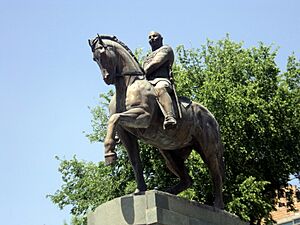

After World War II, Bagramyan continued to command the Baltic Military District. He led operations against anti-Soviet fighters in Lithuania and Latvia. In 1954, he became the chief inspector of the Ministry of Defence. On March 11, 1955, he was made Deputy Minister of Defence and given the rank of Marshal of the Soviet Union. He also led the Military Academy of General Staff.
He spent much time writing articles about Soviet military operations. He also helped write a six-volume book about the Soviet Union's role in World War II. In August 1967, Bagramyan visited North Vietnam with Soviet leaders. They arranged to send weapons and supplies to Vietnam.
Bagramyan retired on April 25, 1968. He became a General Inspector in the Ministry of Defence. In 1971, he published the first part of his memoirs, This is How the War Began. In 1977, the second part, Thus We Went to Victory, was published. In his books, he talked about the Red Army's difficult early battles in the war. He noted that they had to learn how to retreat effectively.
In 1979, another book by Bagramyan, My Memoirs, was published. It included parts from his earlier books. A large part of this book was about Armenian history and issues.

Marshal Bagramyan received many awards from the Soviet Union and other countries. These included two "Gold Star" Hero of the Soviet Union medals and seven Orders of Lenin.
After Marshal Vasily Chuikov died in March 1982, Bagramyan was the last surviving Soviet Marshal who held a high command in World War II. Bagramyan was ill and passed away a few months later, on September 21, 1982, at age 84. He was buried with full military honors at the Kremlin Wall Necropolis in Moscow. A town in Armenia, a military training area, an Armenian Army brigade, and a subway station and street in Yerevan, Armenia, are named after him. In 1997, Armenia created a special medal to honor his 100th birthday.

Honours and Awards
- Soviet Union
| "Gold Star" Hero of the Soviet Union, twice (July 29, 1944, December 1, 1977) | |
| Seven Orders of Lenin (July 29, 1944, November 6, 1945, December 1, 1947, December 2, 1957, December 1, 1972, December 27, 1967, December 1, 1977) | |
| Order of the October Revolution (February 22, 1968) | |
| Order of the Red Banner, three times (November 6, 1941, November 30, 1944, May 17, 1951) | |
| Order of Suvorov, 1st class, twice (August 27, 1943, April 19, 1945) | |
| Order of Kutuzov, 1st class (April 9, 1943) | |
| Order of the Red Star (August 16, 1936) | |
| Order "For Service to the Homeland in the Armed Forces of the USSR", 3rd degree (April 30, 1975) | |
| Medal "For the Defence of Moscow" (May 1, 1944) | |
| Medal "For the Defence of Kiev" (1961) | |
| Medal "For the Capture of Königsberg" (1945) | |
| Medal "For the Victory over Germany in the Great Patriotic War 1941–1945" (1945) | |
| Jubilee Medal "In Commemoration of the 100th Anniversary of the Birth of Vladimir Ilyich Lenin" (1969) | |
| Jubilee Medal "Twenty Years of Victory in the Great Patriotic War 1941-1945" (1965) | |
| Jubilee Medal "Thirty Years of Victory in the Great Patriotic War 1941–1945" (1975) | |
| Medal "Veteran of the Armed Forces of the USSR" (1976) | |
| Medal "For Strengthening of Brotherhood in Arms" (1979) | |
| Medal "For the Development of Virgin Lands" (1956) | |
| Jubilee Medal "XX Years of the Workers' and Peasants' Red Army" (1938) | |
| Jubilee Medal "30 Years of the Soviet Army and Navy" (1948) | |
| Jubilee Medal "40 Years of the Armed Forces of the USSR" (1958) | |
| Jubilee Medal "50 Years of the Armed Forces of the USSR" (1968) | |
| Jubilee Medal "60 Years of the Armed Forces of the USSR" (1978) | |
| Medal "In Commemoration of the 800th Anniversary of Moscow" (1947) | |
| Medal "In Commemoration of the 1500th Anniversary of Kiev" (1982) | |
| Honorary weapon – sword with a golden Soviet emblem (1968) |
- Foreign
| Order of the People's Republic of Bulgaria, 1st class, twice (Bulgaria) | |
| Medal of Sino-Soviet Friendship (China) | |
| Medal "For Strengthening Friendship in Arms", Golden degree (Czechoslovakia) | |
| Order of Karl Marx (East Germany) | |
| Order of Sukhbaatar (Mongolia) | |
| Order of the Red Banner (Mongolia) | |
| Medal "30 years of the Victory in Khalkhin-Gol" (Mongolia) | |
| Medal "50 Years of the Mongolian People's Revolution" (Mongolia) | |
| Medal "30 Years of Victory over Militaristic Japan" (Mongolia) | |
| Medal "50 years of the Mongolian People's Army" (Mongolia) | |
| Order of Polonia Restituta, 5th class, twice (Poland) | |
| Brotherhood of Arms Medal (Poland) |
Memoirs
- Part I: Bagramyan, Ivan Kh. Tak nachilas' voina [This is How the War Began]. Moscow: Voenizdat, 1971.
- Part II: Bagramyan, Ivan Kh. Tak shli my k pobede [Thus We Went to Victory]. Moscow: Voenizdat, 1977.
See also
 In Spanish: Iván Bagramián para niños
In Spanish: Iván Bagramián para niños


